Introduction
At present, the situation at home and abroad has undergone numerous changes. The trade war between China and the United States has been on the verge of explosion and China is facing a critical period of economic transformation and upgrading. New technologies, new formats, and new models such as “Internet Plus,” shared economy, and supply-side reforms have had an impact on the old labor relations management model. Faced with the gradual disappearance of the “demographic dividend” and the urgent need for economic restructuring, the conflict between labor and capital has intensified. In the past, extensive labor relations management methods have been unable to meet the requirements of the times. By establishing a good atmosphere of labor relations, the management of labor relations has been standardized. It has become the focus of current management work to improve employees’ job satisfaction and promote their better initiative and enthusiasm in a good atmosphere.
In China, new generation employees are those who were born after 1st January 1980, including the post-80s, the post-85s, and the post-90s. Nowadays, new generation employees have been the major driving force in companies. From managers’ point of view, they are unstable, having independence of thought, poor self-discipline, and blind confidence. High turnover rate and blurred value orientation of new generation employees are the biggest blocks of companies’ strategic development, which brings huge challenge to managers. Therefore, this research focused on the explicit and implicit work value, their difference, and the relationship between work value, job satisfaction, organizational commitment, and turnover intention.
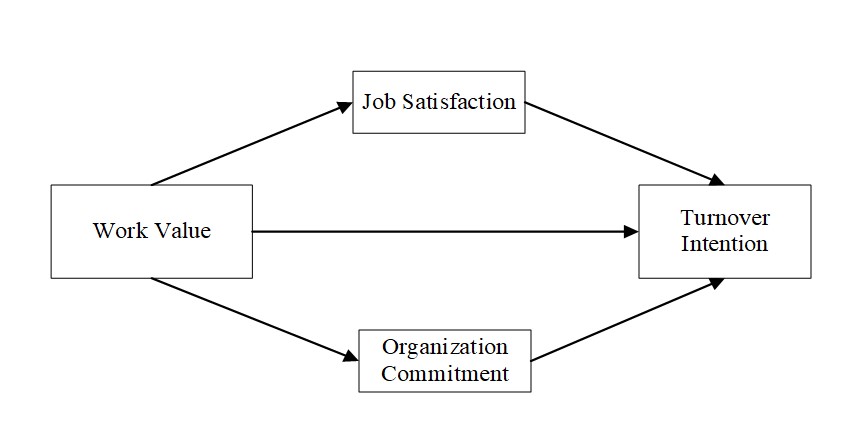
Fig. 1: Proposed model for work value and turnover intention
Literature Review and Hypothesis
The New Generation of Employees
The new generation of employees in this study pointed out that employees born after January 1, 1980 were subdivided into post-80s, post-85s, and post-90s. At present, although more and more scholars are beginning to pay attention to the turnover intention of specific types of employees ,today, many viewed job choices and turnover intions as distinct aspects of work are awared that these are directly related to their job. However, since this was not always the case this new attitude of workers has created problems in the current labor market in China. Younger generations of Chinese workers have become individualistic and materialistic and also tend to seek more challenges and changes, thus causing them to pursue better employment opportunities and seek higher wages (Ralston, Egri, Stewart, Terpstra, & Kaicheng, 1999).
Work values
Values are regarded as the essential concepts that are possessed by individuals and a society.The operational definition of work values is defined as the value judgment of the work itself, work and environment, and work and self-relationship formed by employees in their careers. It belongs to the individual’s internal and stable personality tendency or personality dynamic system, which affects the employees’ external Work behavior and performance. Studying the structure of work values helps us better understand work values.
Turnover Intention
The time always comes when an individual considers the possibility of terminating his or her employment with an organization (Mobley, 1982). Turnover intention has been defined as a conscious psychological willingness to leave an organization (Tett & Meyer, 1993).
Job Satisfaction
Job satisfaction usually refers to a person’s work in the organization, the work itself and related aspects (including work environment, work status, work style, work pressure, challenge, interpersonal relationships at work, etc.) Job satisfaction, as the most-used definition, is ‘a pleasurable or positive emotional state resulting from the appraisal of one’s job or jobexperiences’ . In other words, it is the individual’s pleasure and happiness gained by work life (Keser 2011). The conventional job satisfaction models put forward that pay, nature of work,operating conditions, coworkers and supervision are the determiners in job satisfaction (Keser 2006). In addition, more modern approaches set forth that promotion, fringe benefits, contingent rewards and communication are also the subscales of job satisfaction. It is an important employee attitude variable derived from the evaluation of their work or work experience. Studies have shown that job satisfaction includes satisfaction in five areas: job itself, compensation, promotion opportunities, supervisors and colleagues. Based on whether work can help to achieve individual values, and whether it can meet individual needs and interests, it is reflected in different levels of high and low. High levels of job satisfaction occur when work matches personal needs, interests, and working conditions and interpersonal cooperation are satisfactory.
Organization Commitment
There are a number of definitions of organizational commitment. Organizational commitment has been described as an antecedent of turnover intention(Poznanski & Bline, 1997). Other researchers have demonstrated the importance of organizational commitment in explaining turnover intention (Bluedorn, 1982).OReilly and Chatman combined empirical research to point out that the support path presented by individuals in enterprises and organizations includes three parts: obedience, belonging and consistency(O’Reilly Iii & Chatman, 1986). Obedience reflects the purposeful measures of individual enterprises to obtain rewards; belonging is due to the goals and attitudes of the organization. Allen and Meyer based on the results of empirical research, sorted out, analyzed, and defined the content of three factors, improved the content of organizational commitment, and has become a widely accepted concept of organizational commitment by researchers. Affective commitment denotes “the strength of an individual’s identification with and involvement in a particular organization” (Porter et al., 1974, p. 604), continuance commitment (e.g., Becker, 1960) arises from the recognition that one would lose valued “side bets” (e.g., pension) upon leaving the organization, and normative commitment (Wiener, 1982) denotes a willingness to remain with an organization due to a sense of moral obligation. Although it would be interesting to compare different types of commitment meta-analytically in the context of turnover, our investigation was limited to affective commitment due to the relative scarcity of studies involving the other forms. Organizational commitment has also been recognized as having a significantly negative association with turnover intention(Allen & Meyer, 1996).
Influence of the work value on the turnover intention
Values can steadily influence a person’s behavior and way of doing things. Because of this stable influence, the research on values has become a research hotspot in recent years. During the work, employees will show their likes or dislikes about their work, and they will also show their love or dissatisfaction with the organization. The stable development of such emotions is the work values and the embodiment of values in people’s work.
There are many factors that affect the turnover intention. Amongst these factors, the function of work values to the turnover intention can’t be ignored. Schwartz suggested that the pursuit of intrinsic work values (e.g., personal growth or opportunities for creativity) was likely to be seen as desirable and justified when the value of autonomy is emphasized(Schwartz, 1999). Hofstede suggested that in patriarchal societies motivation may be based more on the acquisition of money and possessions than on quality of life because money is associated with security and stability. Jaw and colleagues believed that, in this respect, Western culture has had an effect on Chinese Confucian dynamism(Jaw, Ling, Wang, & Chang, 2007). A possible explanation for this is that people in management positions in Chinese industries/businesses who have been exposed to Western cultures are thought to work more diligently so they can obtain more rewards that are related to performance, and this is a major feature of management practices in the Western work environment. We therefore form the following hypothesis on the impact of work value on turnover intention:
H1: Work value is negatively related to turnover intention.
The mediating effect of the job satisfaction and organization commitment on the relationship between work values and turnover intention
In previous studies, it has been found that the relationship between job satisfaction and organizational commitment is variable and at times results are contradictory. Bateman and Strasser determined that organizational commitment was the initial affective factor and was an antecedent to job satisfaction(Bateman & Strasser, 1984). Porter et al. (1974) held the opposite view, arguing that satisfaction represents one specific component of organizational commitment. Williams and Hazer were of the view that satisfaction does causally affect organizational commitment(Williams & Hazer, 1986), while Steers found that as an employee’s needs are satisfied by the organization, they develop more commitment to the organization. Chen and Francesco adopted the view that job satisfaction has a causal influence on organizational commitment(Chen & Francesco, 2000).
The expression of work attitude is job satisfaction. Stable values can guide a person’s behavior. In work, it is shown that work values affect employees’ work attitude, that is, they will affect job satisfaction. This has been confirmed in previous studies.Organizational commitment is the emotional dependence of employees on the existing organization, loyalty to the organization and strong emotional dependence on the organization, and the ability to dedicate themselves to the emotional development of the organization.
Most scholars’ research on organizational commitment and job satisfaction is a combination, because the two are interconnected and very similar in some aspects, except that emotional commitment is a more stable job satisfaction. Bateman and Strasser (1984) determined that organizational commitment was the initial affective factor and was an antecedent to job satisfaction. Porter et al. (1974) held the opposite view, arguing that satisfaction represents one specific component of organizational commitment. Williams and Hazer (1986) were of the view that satisfaction does causally affect organizational commitment, while Steers (1977) found that as an employee’s needs are satisfied by the organization, they develop more commitment to the organization.The simple point is that job satisfaction is temporary, and it is a current emotion. Organizational commitment is something deep in the heart. It is an identification with the organization. If a person does not agree with his organization in attitude, then the performance the job satisfaction that comes out will definitely have a certain impact, which in turn will affect the emotions of the organization. Based on the above analyzation, we can form the following hypothesis on the function of job satisfaction and organization commitment on the relationship between work value and turnover intention.
H2a: The job satisfaction plays the mediating effect on the relationship between work values and turnover intention
H2b: The commitment plays the mediating effect on the relationship between work values and turnover intention
Research Methodology
With the objective to contrast the research hypotheses presented, market research was carried out by combining the qualitative and quantitative methodologies that are detailed hereafter.
Context of the research
During the last decade, China has been trying to stimulate economic growth through implementation of innovation. The Chinese government and relevant organizations have issued a number of policies to promote business development by focusing on work value and turnover culture in Chinese universities. China’s increasing focus on work value provides a favourable environment for human resource management research, which can measure the new initiatives’ effect on employee turnover intention.
Setting and participants
In order to empirically contrast the proposed research hypotheses, a quantitative investigation was carried out using surveys of the new generation of employees. To ensure the variability and representativeness of respondents, we selected employees from different cities. we conducted a questionnaire survey on them, covering basic information, work values, job satisfaction, organization commitment turnover intention.
Of the 463 questionnaires distributed, 405 were determined to be valid, of which 58 were subsequently discarded because of incomplete information. The 463 fully completed questionnaires (response rate of 87.5%) were from 196 males (48.4%) and 206 females (51.6%).
Design and measure
The questionnaire was developed and pretested on a small sample of students for validation purposes. The study’s constructs were work values, job satisfaction, organization commitment, and turnover intention. The information that was collected was brought together using a questionnaire in which the variable in the theoretical model was measured with a multi-item scale. This makes it possible to obtain evaluations of psychological variables that cannot be quantified directly(Churchill, 1995). The evaluations were found using the Likert scale of five positions (1 = strongly disagree with the affirmation made and 5 = strongly agree).
Work values
Three dimensions of work values were defined in this study: Suitability,stability,career development and employee status. People-related factors included relationships with colleagues and supervisors, personal growth, recognition, the use of expertise, knowledge, and competence. Job outcome represented the desire for respect, economic rewards, secure and stable lifestyle, benefits, prestige, and social status. Finally, the job itself focused on working conditions, hours worked, degree of autonomy, ideal pursuance, and meaningfulness of job content. The 21 items that were used for measurement of work values were taken from the Work Values Scale (Meyer & Alien, 1991).All statements were measured on a five-point Likert scale ranging from 1 (strongly disagree) to 5 (strongly agree).
The job satisfaction
Following Hochwarter, kacmar, Perrewe(2003), job satisfaction was measured through four statements on a five-point Likert scale ranging, which assessed the degree of attraction of starting a new job for participants.
The commitment
Meyer and Allen developed a 3-component conceptualization that we adapted to measure organizational commitment in this study(Meyer & Alien, 1991). The questionnaire contained 3 items classified as affective commitment, continuance commitment, and normative commitment. Participants rated their responses using a 5-point Likert scale ranging from 1 = strongly disagree to 5 = strongly agree.
Turnover intention
In order to investigate how often respondents seriously considered quitting their job, whether or not they wanted to quit, and/or were actually planning to quit, six items were extracted from a scale developed by Konovsky and Cropanzano (Konovsky & Cropanzano, 1991). Responses followed a 5-point Likert scale ranging from 1 = strongly disagree to 5 = strongly agree.
Result
Descriptive Analysis
Table 1 shows the demographic distribution of the participants.
Table 1: Socio-demographic profile of the nascent entrepreneurs sample
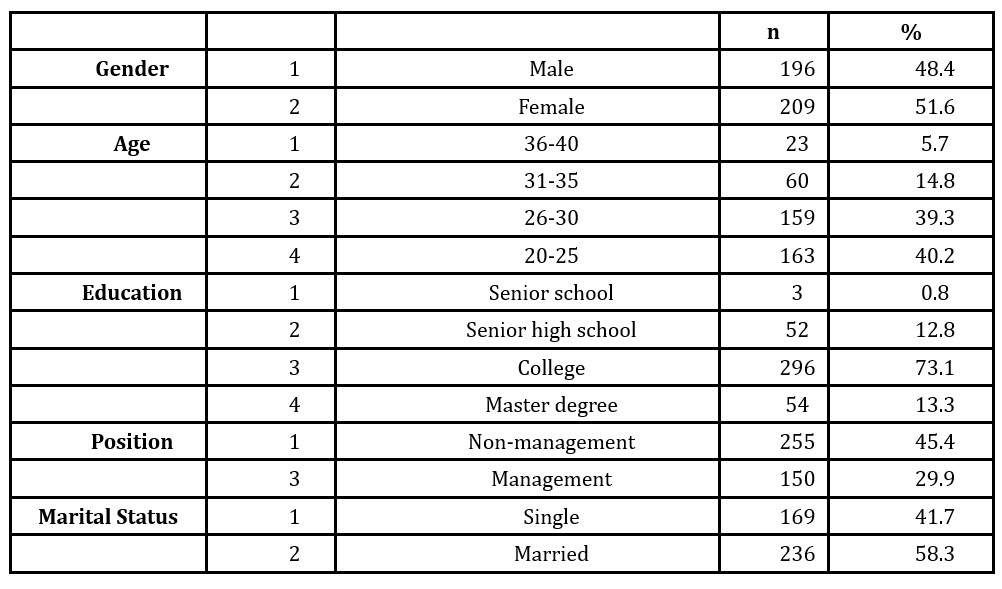
Note:N=405
Assessment of measures and common method bias
In order to test the research model, a Structural Equations Model (SEM) approach is used. This statistical method allows the estimation of causal interrelations between latent factors measured with multi-item scales. Therefore, it is especially appropriate to study psychological variables that are not directly observable, as is the case in this research. In particular, SEM approach requires the development of two levels of analysis: first, Confirmatory Factor Analysis (CFA) is carried out to confirm the psychometric properties (reliability, convergent validity and discriminant validity) of the measurement scales (measurement model), and then, structural model is estimated to test the causal interrelations established in the theoretical model. In this research, the measurement model and the structural model are estimated through the Maximum Likelihood Robust method, using EQS 6.3 computer program.The results of the CFA summarized in Table 2 confirm the convergent validity of all the measurement scales.
Table 2: CFA for model variables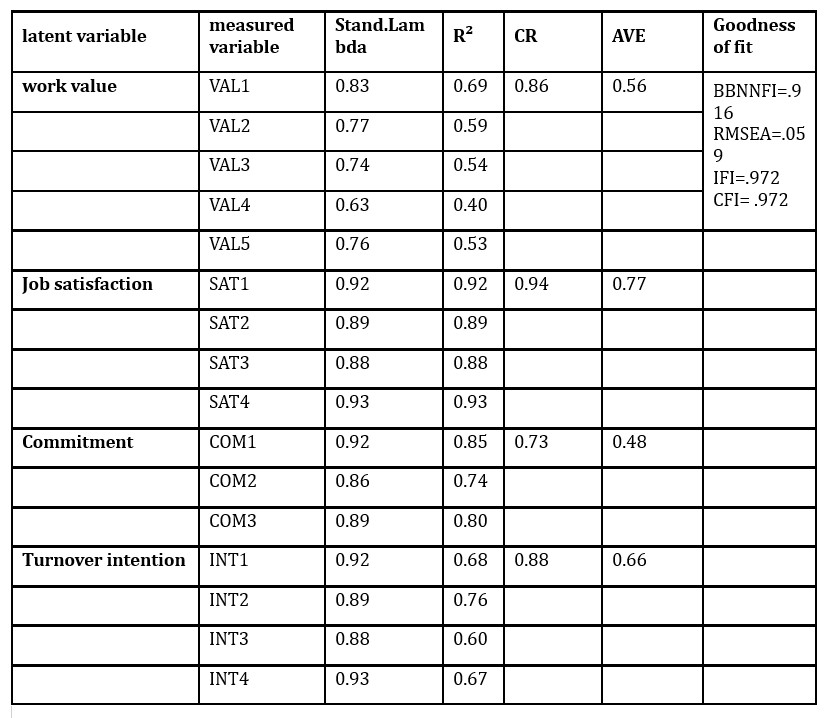
The method proposed by Murtagh and Heck is used to test the validity of aggregation, that is, the degree of correlation between tools used to measure potential factors(Anderson & Gerbing, 1988). Test the convergence and discriminant validity according to the procedures proposed by Steenkamp and Trijp (1991) and Anderson and Gerbing (1988). According to the annotations proposed by Steenkamp and Trijp , if the reliability of all items reaches a significance level of 95% and the standardized lambda coefficient is higher than 0.5, the convergence validity of the metric can be confirmed. The CFA results summarized in Table 3 confirm the consistent validity of all measurement scales(Steenkamp & van Trijp, 1991).
In addition, the calculation results of the goodness-of-fit index indicate the correctness of the model. We use the statistical data given by EQS6.3. According to the parameter indicators proposed in the literature widely used in SEM(Byrne, 1994), Table 3 confirms that the BBNNFI, IFI, and CFI statistics exceed the recommended minimum of 0.9, while RMSEA is below the maximum limit of 0.08, so the model has a good fit.
Discriminant validity refers to the degree to which there is a correlation but a difference between two potential factors. Anderson and Gerbing (1988) argued that if the confidence interval of the correlation between potential factors does not include 1 (the maximum correlation), then the discriminant validity can be determined. The results summarized in Table 4 confirm the discriminant validity of all measurement scales.
In addition, the reliability of the scale was evaluated by calculating the combined effect of Cronbach`s a, Composite reliability and AVE(Bagozzi & Yi, 1988). The values of these statistics (summarised in Table 3) are in each case above the required minimum values of 0.7 and 0.5. Therefore, the internal reliability of the assumed structure is supported.
Table 3: Confidence intervals for the correlations between pairs of latent variables
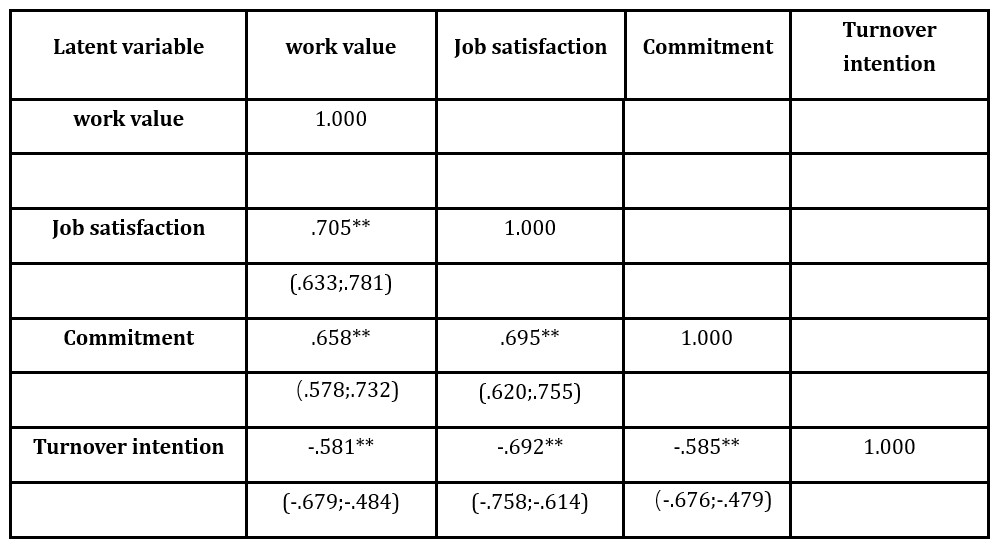
It can be seen from Table 3 that work values significantly affect turnover intentions, and work values are negatively correlated with turnover intentions. Hypothesis H1 is supported.
Mediation Analysis
Work values are negatively related to turnover intentions. In order to test the proposed mediation effect, we use the two predictors of job turnover and organization commitment as the predictors for regression analysis. Next, we conducted a regression analysis on the main effect and the mediation effect of turnover intentions, and found that for each model, work values significantly predicted job satisfaction and organization commitment, providing support for further mediation tests on each model. Subsequently, we loaded two variables, job satisfaction and organization commitment, and verified them according to the mediation effect test model shown in Figure 2 and Figure 3.
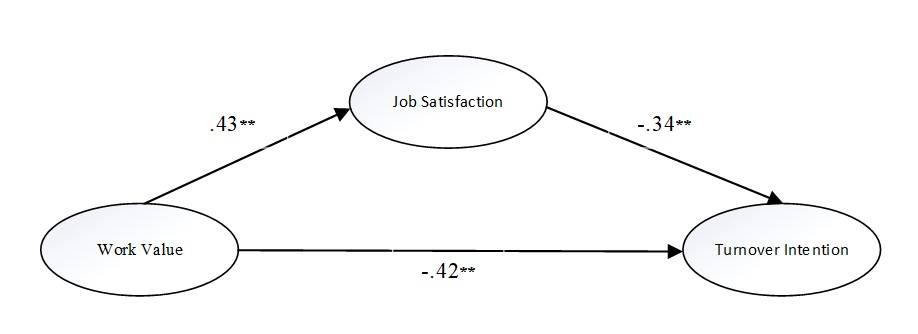
Fig. 2: Test diagram of the mediating effect of Job satisfaction between Work value and Turnover Intention
Table 4: Fitting index of the job satisfaction mediation model

The validation parameters in Table 4 indicate that the model has a good fit, so the model studied is acceptable. Figure 2 shows that the mediating effect of job satisfaction between work value and turnover intention is significant.H2a mediation effect hypothesis holds that job satisfaction plays the mediating effect on the relationship between work values and turnover intention.
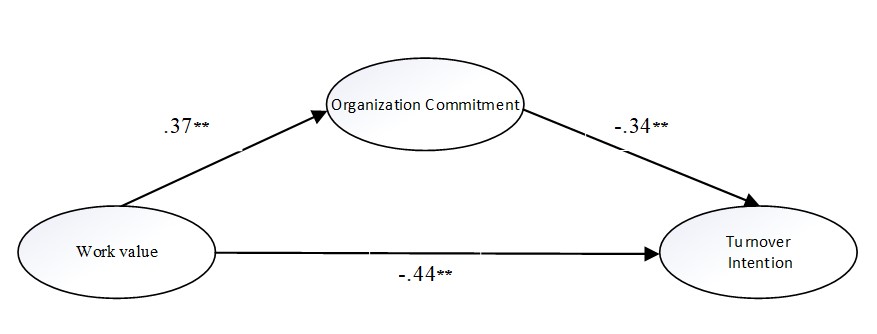
Fig. 3: Organization Commitment test chart of the mediating effect between work values and turnover intention
Table 5: Fitting index of the organization commitment mediation model

The validation parameters in Table 5 indicate that the model has a good fit, so the model studied is acceptable. Figure 3 shows that the mediating effect of organization commitment between work value and turnover intention is significant.H2b mediation effect hypothesis holds that the organization commitment plays the mediating effect on the relationship between work values and turnover intention.
Discussion and Implications
Conclusions and Discussion
In this study, work values, job satisfaction, and organizational commitment were found jointly and individually to have a significant influence on turnover intention.We found that when a company’s management supports its employees’ value systems, the employees tended to have a higher commitment to the organization.Based on the analysis of the mediation effect, this paper explores the impact mechanism of the new generation of employees’ work values on turnover intentions, constructs an optimized multiple intermediary model(Mitchell, 1999), and discusses the impact mechanism of the work values of the new generation of employees on turnover intentions. The study lays the foundation.
Based on the perspective of multiple intermediary roles, this article studies the turnover intention from a new perspective through argumentation, design, induction of job satisfaction, and organizational commitment, and looks at the problem of turnover intention in the perspective of intergenerational differences, deepening the discussion of the new generation of employees. Of the various variables, in this study the aim was to ascertain the effects of work values on job satisfaction, organizational commitment, and turnover intention in a Chinese contextCombined with the literature, Western scholars’ research on the work values of employees in organizations has a deep characteristic that reflects the western cultural background. In the Chinese context, its applicability and the degree of differences are explored and compared(Mobley, Horner, & Hollingsworth, 1978).
The results of this study may provide some guidelines for managers in understanding the work values of the younger generation of Chinese employees, and this could lead to implementation of more effective policies for improving employee retention. Some companies in China have not tried to find ways to reduce turnover because the labor supply has been plentiful. This situation has changed and it has become increasingly difficult for Chinese firms to recruit new employees. Our results confirming that job satisfaction and organizational commitment were strong predictors of turnover intention, indicate that companies should conduct periodic surveys of employees on their job satisfaction and organizational commitment. This could lead to a better understanding of employee reactions and feelings about, and opinions of, the company’s current operations or policies; it could also help management to take precautions against unexpected developments.
Limitations and Future Studies
There are some potential limitations in the present study that inform possibilities for future research. Attempts to explain an increase or decrease in the level of organizational commitment and turnover intention can involve many factors. Work values and job satisfaction are just two factors that were used in this study; however, there are many other factors that could be considered or examined. This study might also have been limited by the quantification methods that were used. Future researchers could include qualitative measures for obtaining additional information from the participants. Generalizing the opinion of individuals could provide a more complete picture of the relationships between organizational commitment and turnover intention. Additionally, the questionnaires were distributed in the Chengdu area; hence, their representation might not be generalizable to other areas in China(Mitchell, 1999; Palich & Ray Bagby, 1995).
First, the target of the investigation was a single industry. The respondents possessed a high level of education and other specializations, so they are not necessarily representative of the general workforce in China (e.g., people working in the service and manufacturing industries might possess different work values relating to organizational commitment and turnover intention). Future researchers should test the reliability of the findings with other sectors of business and industry, as well as taking demographics into account as control variables in the analysis. Additionally, there is a possibility that the structure of this research might have been too simplistic, and the survey may also suffer from common method variance. Consequently, our findings may not be generalisable to developed economies in individualistic cultures like those of the USA or Europe(Hofstede, 1993). It is possible to replicate this theoretical model in other countries with different economic, cultural and legal characteristics, which could affect the effects of the risk dimensions associated with work value, as a future line of research. Finally, longitudinal studies for turnover intention are required. Future studies should also include other related variables, such as the personal characteristic variables and situational variables to clarify how turnover intention will be transmitted over a longtime.
(adsbygoogle = window.adsbygoogle || []).push({});
References
- Allen, N. J., & Meyer, J. P. (1996). Affective, continuance, and normative commitment to the organization: An examination of construct validity. Journal of Vocational Behavior, 49(3), 252-276. doi:10.1006/jvbe.1996.0043
- Anderson, J. C., & Gerbing, D. W. (1988). Structural Equation Modeling in Practice: A Review and Recommended Two-Step Approach. Psychological Bulletin, 103(3), 411-423. doi:10.1037/0033-2909.103.3.411
- Bagozzi, R. P., & Yi, Y. (1988). On the evaluation of structural equation models. Journal of the Academy of Marketing Science, 16(1), 74-94. doi:10.1007/BF02723327
- Bateman, T. S., & Strasser, S. (1984). A longitudinal analysis of the antecedents of organizational commitment. Academy of Management journal. Academy of Management, 27(1), 95-112. doi:10.2307/255959
- Bluedorn, A. C. (1982). A Unified Model of Turnover from Organizations. Human Relations, 35(2), 135-153. doi:10.1177/001872678203500204
- Byrne, B. M. (1994). Structural Equation Modeling with EQS and EQS/Windows.
- Chen, Z. X., & Francesco, A. M. (2000). Employee demography, organizational commitment, and turnover intentions in China: Do cultural differences matter? Human Relations, 53(6), 869-887. doi:10.1177/0018726700536005
- Churchill, G. A. (1995). Marketing Research; Methodological Foundations,7th ed. Marketing Research: Methodological Foundations.
- Hofstede, G. (1993). Cultural constraints in management theories. Academy of Management Executive, 7(1), 81-94.
- Jaw, B., Ling, Y., Wang, C. Y., & Chang, W. (2007). The impact of culture on Chinese employees’ work values. Personnel Review, 36(1), 128-144. doi:10.1108/00483480710716759
- Konovsky, M. A., & Cropanzano, R. (1991). Perceived Fairness of Employee Drug Testing as a Predictor of Employee Attitudes and Job Performance. Journal of Applied Psychology, 76(5), 698-707. doi:10.1037/0021-9010.76.5.698
- Meyer, J. P., & Alien, N. J. (1991). A three-component conceptualization of organizational commitment. Human Resource Management Review, 1(1), 61-89. doi:10.1016/1053-4822(91)90011-Z
- Mitchell, V. W. (1999). Consumer perceived risk: Conceptualisations and models. European Journal of Marketing, 33(1-2), 163-195.
- Mobley, W. H. (1982). Employee Turnover: Causes, Consequences, and Control.
- Mobley, W. H., Horner, S. O., & Hollingsworth, A. T. (1978). An evaluation of precursors of hospital employee turnover. Journal of Applied Psychology, 63(4), 408-414. doi:10.1037/0021-9010.63.4.408
- O’Reilly Iii, C., & Chatman, J. (1986). Organizational Commitment and Psychological Attachment. The Effects of Compliance, Identification, and Internalization on Prosocial Behavior. Journal of Applied Psychology, 71(3), 492-499. doi:10.1037/0021-9010.71.3.492
- Palich, L. E., & Ray Bagby, D. (1995). Using cognitive theory to explain entrepreneurial risk-taking: Challenging conventional wisdom. Journal of Business Venturing, 10(6), 425-438. doi:10.1016/0883-9026(95)00082-J
- Poznanski, P. J., & Bline, D. M. (1997). Using structural equation modeling to investigate the causal ordering of job satisfaction and organizational commitment among staff accountants. Behavioral Research in Accounting, 9(1), 154-171.
- Ralston, D. A., Egri, C. P., Stewart, S., Terpstra, R. H., & Kaicheng, Y. (1999). Doing business in the 21st century with the new generation of chinese managers: A study of generational shifts in work values in China. Journal of International Business Studies, 30(2), 415-427. doi:10.1057/palgrave.jibs.8490077
- Schwartz, S. H. (1999). A theory of cultural values and some implications for work. Applied Psychology, 48(1), 23-47. doi:10.1080/026999499377655
- Steenkamp, J. B. E. M., & van Trijp, H. C. M. (1991). The use of lisrel in validating marketing constructs. International Journal of Research in Marketing, 8(4), 283-299. doi:10.1016/0167-8116(91)90027-5
- Tett, R. P., & Meyer, J. P. (1993). JOB SATISFACTION, ORGANIZATIONAL COMMITMENT, TURNOVER INTENTION, AND TURNOVER: PATH ANALYSES BASED ON META‐ANALYTIC FINDINGS. Personnel Psychology, 46(2), 259-293. doi:10.1111/j.1744-6570.1993.tb00874.x
- Williams, L. J., & Hazer, J. T. (1986). Antecedents and Consequences of Satisfaction and Commitment in Turnover Models. A Reanalysis Using Latent Variable Structural Equation Methods. Journal of Applied Psychology, 71(2), 219-231. doi:10.1037/0021-9010.71.2.219










